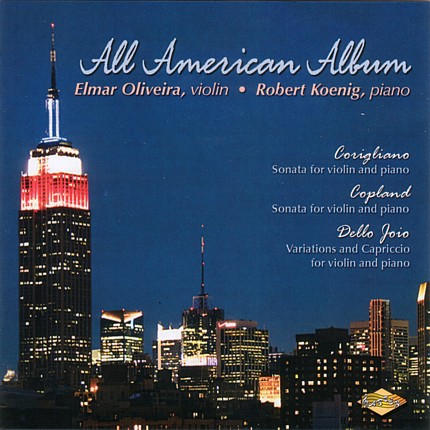ARTEK Recordings
Reviews of CD 35

Click to Order Recording

ARTEK Recordings |

|
John Corigliano wrote his Violin Sonata with his parents in mind (Corigliano’s father served as concertmaster of the New York Philharmonic and his mother played the piano). His lifelong exposure to the violin is apparent from such disparate elements as the first measures of the opening Allegro and the Andante’s singing theme and later leaping passages. Elmar Oliveira, playing the 1729–30 Stretton Guarneri del Gesù, commands attention both technically and tonally in this idiomatic work. The double-stops at the beginning of the work, for example, crackle like lightning, flashing in the upper registers. He employs portamentos sparingly but each time to great effect. The Lento draws upon a more rhetorical expressive manner; Oliveira’s soliloquy in the middle section displays both his own tonal eloquence and that of his instrument. His reading of the finale is jaunty and quicksilver. Robert Koenig complements Oliveira’s sensitivity in the slow movements and his virtuosity in the finale. The engineers at the Performing Arts Center at SUNY Purchase captured both instruments up close at the recording session on May 10, 2006, providing a colorful tonal portrait of both. Aaron Copland’s Sonata, written during WW II, has had two decades more than Corigliano’s to work its way into violinists’ repertoire. The more somber first movement, intensified in the slow second, lead to a finale full of the composer’s typical nose-thumbingly offbeat rhythmic play, but it, too, turns serious. If Oliveira doesn’t play with Isaac Stern’s raw energy (with the composer at the piano, issued in Sony’s “A Life in Music” series, SONY 64 533), he’s clean and incisive throughout, with an appropriate hint of nostalgia. Norman Dello Joio’s Variations and Capriccio, beginning with a theme and six variations followed by a Capriccio that opens and closes on a note of thoughtful lyricism, makes an accessible and relatively cheerful companion piece to the two sonatas, each of which apparently recounts some painful autobiographical elements. The variations range from the skittish second to the more solemn third and sixth. Oliveira and Koenig play Dello Joio’s piece with a straightforward energy and lean tonal beauty similar to those they achieved in their readings of the other works on the program. The spanking cleanliness of Oliveira’s readings may motivate some listeners to seek loamier readings of Corigliano’s Sonata, perhaps in a more highly nuanced performance from Joshua Bell (or brighter ones, like that by Glen Dicterow, on Cala 514). Anne Akiko Meyers gave a performance of Copland’s Sonata in which the more reflective earlier movements didn’t succeed in their way as did her incisive playing in the last movement on RCA Victor Red Seal 68114. Stern and Copland still offer strong, authoritative competition (when Stern is playing unaccompanied at the beginning of the last movement, for example, his jagged fragments sound like Copland rather than simple impudence). Oliveira’s program should still appeal to collectors of Americana and to those who have followed his career. Recommended, not only to them, but more generally as a program of 20th-century American works not often encountered in a single program.
- Robert Maxham
All Music Guide review:
This album of violinist Elmar Oliveira and pianist Robert Koenig does what more albums should be doing: taking lesser-known works and showing the listener why he/she should be household names through magnificent and convincing performances. The three works on the program give a wonderful cross-section of what American art music has to offer, from the neo-Romantic Corigliano sonata to the more rural sensibilities of the Copland sonata. Oliveira and Koenig present a performance of true chamber music, never putting the importance of one instrument over the other. Oliveira's playing is exceptionally multi-faceted, easily changing gears from the simple, cantabile playing in the Copland second movement to the maniacal and sprightly finale of the Corigliano. Articulation is crisp and uniform between the violin and piano; rhythm, as is necessary for music of this genre, is precisely executed. The feature that perhaps brings the most to this collection of American music is the unbridled energy demonstrated by both musicians. Even slow movements have a certain forward momentum that sustains their energy throughout. All of this stellar playing truly honors the compositions of these three American composers and demonstrates that there are still works out there that simply haven't had a commanding performance necessary to bring it into the limelight. This album absolutely deserves a slot on just about anyone's shelf.
~ Mike D. Brownell